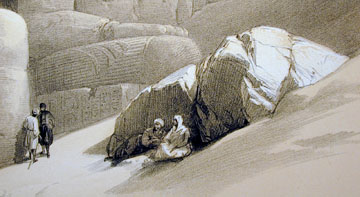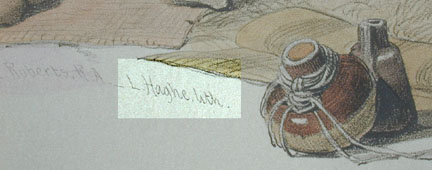

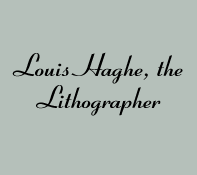
Once Roberts had settled on F.G. Moon as his publisher, he turned his attention to completing the drawings and watercolors from which the lithography would be produced. It was left to Moon to locate and hire the lithographers, the colorists, and the authors who would provide the written text for the volumes. For the lithography Moon considered J.D. Harding, a watercolorist, as well as a team which would include Charles and Louis Haghe, brothers from Belgium.
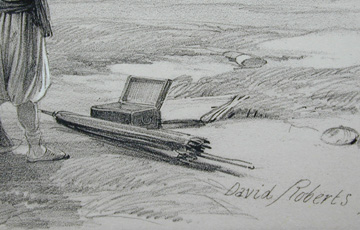 Roberts
favored Louis Haghe, who had built a well deserved reputation as a lithographer
who could transfer the feel of the artist's work, as well as the detail, to
the finished lithographs. In the end, with Roberts' encouragement Louis Haghe
took on the entire project himself, a monumental task which would span seven
years. The choice of Haghe, coupled with the double tintstone lithography technique,
turned out to be critical to the quality and enduring popularity of the finished
works. Haghe was a talented artist in his own right, and was able to transfer
the nuances of Roberts'drawings and style to the lithographic stones. Haghe
worked from drawings and watercolors provided for each image by Roberts. The
actual lines and tones on the stones and in the resulting prints, however, are
Haghe's. As seen in the detail at right from Island of Graia, Gulf of Akaba,
his confidence shows in the way he was able to draw the lithographic crayon
on the stone quickly and seemingly casually, while capturing the detail, tone
and mood of Roberts' original works. Haghe was aided in this regard by Roberts'
own bold drawing style, learned from his days of quickly painting large volumes
of theatrical sets, which lent itself to accurate reproduction using the stone
lithograph technique.
Roberts
favored Louis Haghe, who had built a well deserved reputation as a lithographer
who could transfer the feel of the artist's work, as well as the detail, to
the finished lithographs. In the end, with Roberts' encouragement Louis Haghe
took on the entire project himself, a monumental task which would span seven
years. The choice of Haghe, coupled with the double tintstone lithography technique,
turned out to be critical to the quality and enduring popularity of the finished
works. Haghe was a talented artist in his own right, and was able to transfer
the nuances of Roberts'drawings and style to the lithographic stones. Haghe
worked from drawings and watercolors provided for each image by Roberts. The
actual lines and tones on the stones and in the resulting prints, however, are
Haghe's. As seen in the detail at right from Island of Graia, Gulf of Akaba,
his confidence shows in the way he was able to draw the lithographic crayon
on the stone quickly and seemingly casually, while capturing the detail, tone
and mood of Roberts' original works. Haghe was aided in this regard by Roberts'
own bold drawing style, learned from his days of quickly painting large volumes
of theatrical sets, which lent itself to accurate reproduction using the stone
lithograph technique.
Haghe could work in fine detail when needed, however, and was a master of the
sophisticated techniques necessary to coax various tones, shades and textures
from the stones. The detail and delicacy in the execution of the face of Ramses
II from The Great Temple of Aboo Simbal, below right, is one of the finest
works of tintstone lithography known. 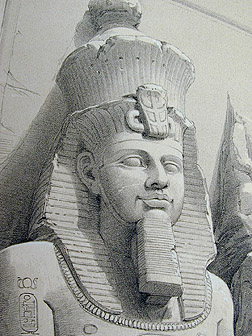
Haghe's ability to produce dramatic highlights and shadows, as shown below
in another detail from the same lithograph, delighted Roberts, and the two became
fast friends, making several trips to the continent together in the ensuing
years. Later, Haghe would become a principal in Day & Sons, which published
a later quarto edition of Roberts' works, and the firm name would become Day
& Haghe. Of Haghe, Roberts stated "There can be only one opinion as
to the masterly manner in which he executed his work" - high praise from
one accomplished artist to another.
